#Tribeca Film Institute
Explore tagged Tumblr posts
Text
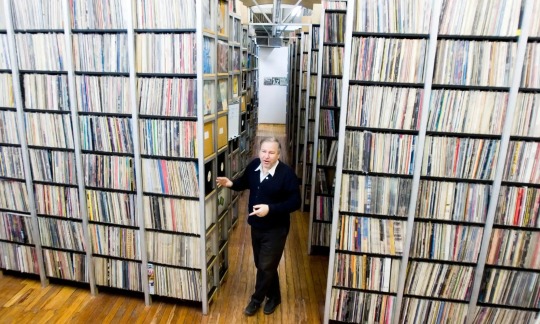
Bob George in the ARC NYC stacks. Photograph: unknown/ARC NYC ...
‘No one else is saving it’: the fight to protect a historic music collection ...
It all started in a loft in Tribeca, New York, long before it was a trendy neighbourhood. “I had 47,000 records and nobody wanted them,” recalls Bob George, who had just published a discography of punk and new wave music. “That led a lot of people coming to me and saying you have to save this stuff; no one else is saving it. That got the ball rolling in my loft in what is now fashionable Tribeca, which was an incredibly unfashionable war zone in 1974 when I was first there.”
George turned his record collection into the ARChive of Contemporary Music (Arc) in 1985 with co-founder David Wheeler. The non-profit music library and research centre now contains more than 3m sound recordings or over 90m songs, making it one of the biggest popular music collections in the world. Donors and board members have included David Bowie, Jonathan Demme, Lou Reed, Martin Scorsese and Paul Simon.
The Arc is not open to the public but has been a vital resource for film-makers, writers and researchers ranging from Ken Burns looking for a song for his series Baseball to the new Grammy Hall of Fame and Museum in Los Angeles needing cover art for its inducted recordings. Now, however, this unique treasure trove is under existential threat.
The Arc cannot remain at its current Hudson Valley premises indefinitely and is in need of a new and bigger home. “We have to move and we don’t know when we’ll have to move and the collection is really at risk because it’s all on pallets,” says George, who dreams of a patron like James Smithson, the British scientist who left his estate to the US to found the Smithsonian Institution. “We’re looking for someone to help us buy a very wonderful property or for us to build a new building on vacant land in upstate New York.”
After growing up in Youngstown, Ohio, George moved to New York in 1974 as a visual arts student and started collecting records as a DJ. In 1981 he released Laurie Anderson’s first single, O Superman, which sold nearly a million copies worldwide and made it to number on the UK singles chart. He was a guest on John Peel’s beloved BBC radio show, sneaking in little-known records from New York, and took music to European broadcasters too. People kept giving him records that other collections turned down.
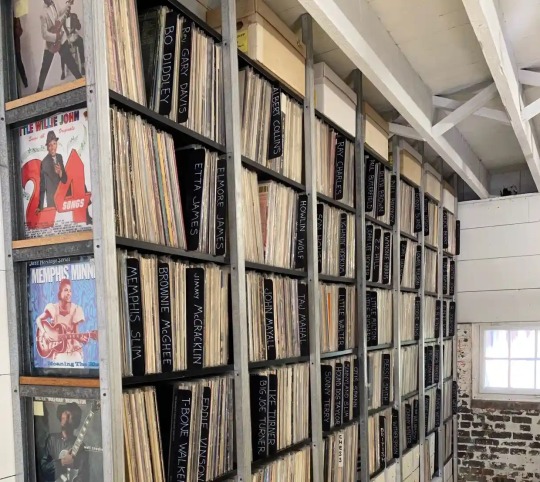
Some of the 18,000 recordings in the Keith Richards Blues Collection. Photograph: Arc NYC
“I was doing the book and then doing Peel shows and it accidentally became this large collection that nobody wanted. They kept saying, oh, we collect classical, we collect Broadway, we collect ethnic music. I said, well, I have funk, reggae, African and hip-hop and they said, oh, no, we don’t collect any of that. Forty years later, I say, you put all those together and that’s what music has become.”
The simple goal of the archive, which has always had a peripatetic existence, is preservation. “We have no interest in quality,” George cheerfully admits. “It started that way from the very beginning because there’s no way to tell what’s valuable in the future. Everybody brings their own criteria and tastes to things in their own time. But the future is quite different, as we hope.”
The archive has never received aid from any city, state or federal organisation but its scale gives the Library of Congress a run for its money. It has absorbed major collections from musicians and fans and is home to most of Rolling Stone Keith Richards’ extensive blues inventory.
George dispatched two semi-trailers to a condemned house in Boston sinking under the weight of Jeep Holland’s set of more than 125,000 recordings and over 2,500 signed albums from the likes of the Stones, Jimi Hendrix, Bob Marley and the Sex Pistols. “Going towards the bathroom, he has a gas stove, the pilot light is on, there are records in the oven. It was just a storage space ... His car had become so full of records that he abandoned it and rented a car.”
George has made repeat trips to countries such as Brazil, Cambodia, Colombia, Cuba, Japan, Jordan, Laos and Thailand. The Arc contains Demme’s personal collection of Haitian albums. More than 150,000 pieces of world music have been catalogued; there are plenty more to do. “We’ve tried to get as much of that material as possible so that collection is just fabulous.”
The Arc preserves copies of every recording in all known formats. It has electronically catalogued more than 400,000 sound recordings and digitised 200,000 with the Internet Archive – more than any other public university or private library in America. It also contains more than 3m pieces of material including photos, videos, DVDs, books, magazines, press kits, sheet music, ephemera and memorabilia.
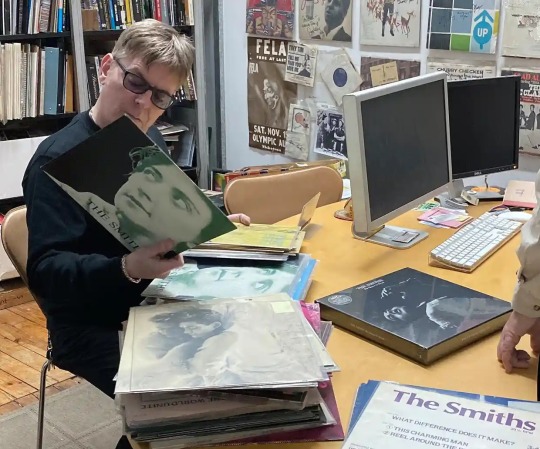
The late Andy Rourke of the Smiths at Arc looking at Smiths records he had never seen. Photograph: Arc NYC
George says: “We catalogued 105,000 singles just recently; we have another 200,000 or 300,000 to go. This is the first way a band at one time got their feet in the water. They put out one or two or three singles. If they did hits, they got the chance to do an album and so much of this material does not exist on LP or CD. Little by little more of it might be streaming because of YouTube, as people can get away with murder on YouTube, which is great, but YouTube will disappear. Everything commercial will disappear.”
Among those who have turned to the archive is the Oscar-winning director Ang Lee, who wanted records by the singer Bert Sommer for his film Taking Woodstock. “The archive is amazing because we don’t know what we have until somebody needs it. We’ve been into the stacks and we found five LPs by Bert Sommer. For me, it’s like I have no idea who this guy is and what he did; he’s sort of a folkie. For Quincy Jones, we just sent him a list of the 8,000 things that he’s either produced or on.
“Research was how we basically stayed alive along with the largesse of the rock stars or celebrities that we had hooked up with. The idea was never to open to the public but that’s what we want to do now. I don’t think it’s untrue that we’re one of the largest in the world and that we want to make that available. We’ve tried to save two copies so there will always be a listening copy and then that would then become a listening library.”
George hopes the new archive will be open to students, educators, historians, musicians, authors, journalists and the general public. An anonymous donor has come forward with a million dollars to help realise that dream but more money is urgently needed. One possible new home is an abandoned IBM campus spanning 34 acres, although that would cost $8-10m. George is considering partnering with an upstate university and has plans to offer residencies for scholars.
“People could come in and produce a work, and that would go out into the world. It could be a blog, essay, tape, compilation, new recording, whatever. We’re really quite un-academic. I’m against it somewhat and I’d like people to have ideas and bring those ideas and put them back into the world as opposed to making it an interactive experience for everybody. I don’t want to be Disney World. It’s nice to have seminars. It’s nice to have listening parties. It’s nice to have dances.”
source
6 notes
·
View notes
Text
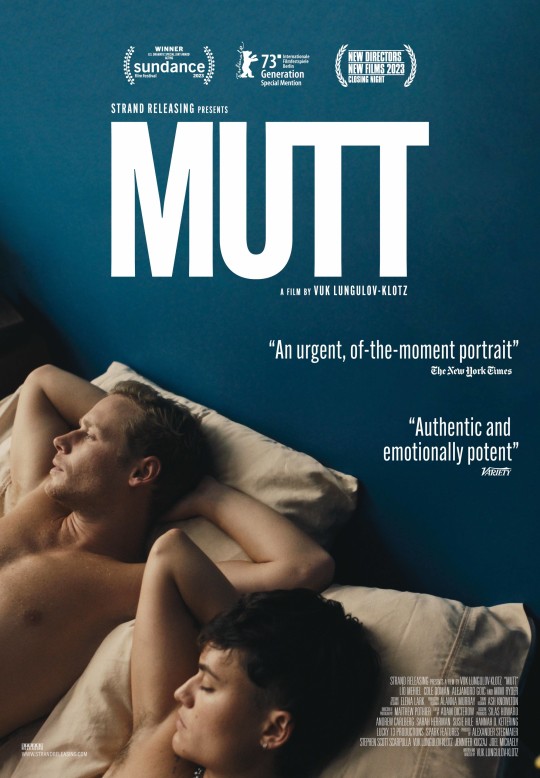
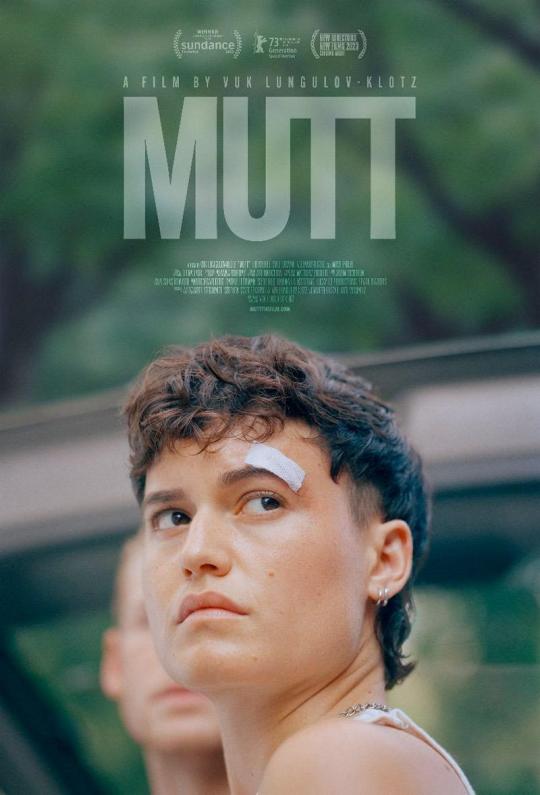
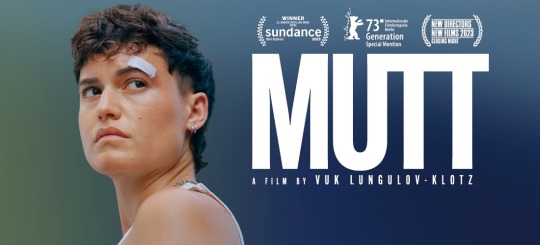
Mutt 2023
Fena, a young trans guy bustling through life in New York City, is afflicted with an incessantly challenging day that resurrects ghosts from his past. Laundromats, subway turnstiles, and airport transfers are the hectic background to this emotional drama that overlaps past, present, and future. Settling the disharmony of transitional upheaval in relationships familial, romantic, and platonic is Fena2s task at hand, and his resulting juggling act is equal parts skillful, fumbling, and honest. In negotiating his obliqueness, the poignant moments he finds between himself and others as the distance between them closes are warm, true, and touching
Q&A with MUTT Filmmaker Vuk Lungulov-Klotz and Stars Lío Mehiel, Cole Doman & MiMi Ryder
Chilean and Serbian immigrants, he was raised between Chile, the US, and Serbia. As a transgender storyteller, he hopes to expand queer narratives. His work focuses on intimate moments we often miss if we're not looking. Mutt is his debut feature film. With his feature film script, MUTT, he is an alum of the Sundance Institute Labs, the Inside Out Financing Forum, and was a top five finalist for the Tribeca / AT&T Untold Stories Grant. His award winning trans-themed short film, "Still Liam," played at festivals internationally and earned the attention of celebrated queer filmmakers Ira Sachs and Silas Howard, who have both become mentors. Vuk is also an alum of the Ryan Murphy HALF Initiative Program, where he completed a mentorship under director Janet Mock on the FX series POSE. He lives in Brooklyn, NY.
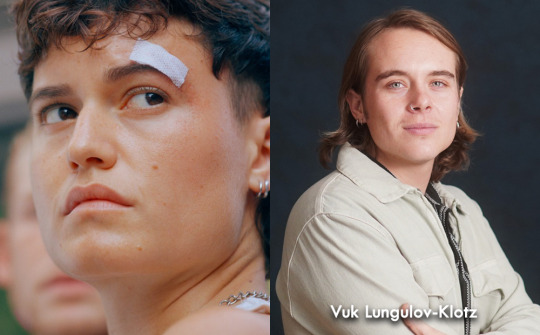
Lío Mehiel is a Puerto Rican and Greek artist, actor, and filmmaker. Their work spans film, television, multimedia installation, theater, and events. They are fascinated by the inherent contradiction of the trans experience — one deeply rooted in the body while also transcending beyond the body. Lío began their career as a professional salsa dancer and child actor on Broadway. They can now be seen on shows like WeCrashed (Apple+) and Tales of the City (Netflix). MUTT is their feature film debut. As a filmmaker, Lío produced Chaperone, a queer short film which premiered at Sundance 2022. They wrote, directed, produced, and starred in Disforia, a short film which premiered at Outfest Film Festival in 2018. They are now stuck inside of a psychomagic act with this story as they write the feature script version and confront their own medical transition. As an installation artist, their immersive piece Arcade Amerikana was included in the list of 10 Best Immersive Shows in NYC by Time Out and GOTHAMIST. Lío is currently the producer and creative director of Angels, a developing collection of stone sculptures of transgender humans. The works were first featured as part of a pop-up installation at Outfest LA in 2022, and will be debuted in full at SIZED Gallery LA in 2023. Lío is a co-founder of Voyeur Productions with Russell Kahn and Dulcinee DeGuere. They attended Northwestern University, and are an alumni of the Emerge NYC residency program for artists and activists. Photo credit: Jordan Rossi
Cole Doman is a trained stage and film actor living in Brooklyn, NY. During his time in Chicago, he studied at the School at Steppenwolf under Amy Morton, Tarell Alvin McCraney, Michael Patrick Thornton, and more. Chris Jones of the Chicago Tribune named Cole among the "Hot New Faces of Chicago Theater" in 2016. He made his film debut as the titular role in the critically acclaimed HENRY GAMBLE'S BIRTHDAY PARTY directed by Stephen Cone. He has profiles with IndieWire, Brooklyn Magazine, OUT, Milk.xyz, and was featured as one of "Best Breakout Performances of 2016" by The Film Stage. He can also be seen in Alan Ball's UNCLE FRANK (Sundance 2020, Amazon Studios) as young Frank Bledsoe played by Paul Bettany. On television he has appeared in Let the Right One In, Gossip Girl, Modern Family, Law & Order: SVU, Chicago PD, Equal, and Shameless. He developed & stars in the short film Starfuckers (MUBI) directed by Antonio Marziale which was presented in competition at Sundance Film Festival, Berlinale, and Telluride Film Festival. Other forthcoming films include: Matt Fifer’s sophomore feature TREATMENT for AMC’s Shudder and Zia Anger’s debut feature MY FIRST FILM for MUBI. Mostrecently, he starred in the world premiere of Your Own Personal Exegesis by Julia May Jonas at Lincoln Center Theatre, directed by Annie Tippe, for which his performance was lauded by The New York Times and even cartooned by The New Yorker.
4 notes
·
View notes
Text
It's been more than a month since a dozen civil rights and religious groups say they sent a letter to the White House calling on President Joe Biden sign an executive order to study reparations by Juneteenth, or this Sunday, June 19, marking the emancipation of enslaved African Americans.
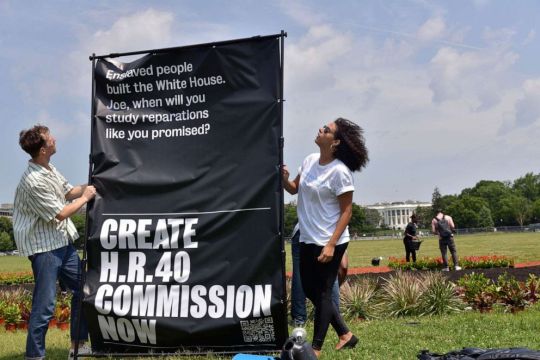
Reparations activists outside new art installation calling on President Joe Biden to sign an executive order on reparations in Washington.
Human Rights Watch
The study activists wants comes after a decades-long push to establish a 13-person reparations commission in Congress.

A art installation calling on President Joe Biden to sign an executive order on reparations stands in Washington.
Human Rights Watch
Shortly after the end of the Civil War, Union leaders promised formerly enslaved families "40 acres and a mule" -- a promise never fulfilled.
However, a reminder of the centuries-old promise has languished in Congress for decades. H.R. 40, the Commission to Study and Develop Reparation Proposals for African Americans Act, has been introduced in every legislative session since 1989.
The measure seeks to establish a commission to study "and consider a national apology and proposal for reparations for the institution of slavery, legal and other racial and economic discrimination, and the impact of these forces on living African Americans, to make recommendations to the Congress on appropriate remedies ..."
In recent years, the bill has gained some political traction.
In 2019, House Speaker Nancy Pelosi, hundreds of members of Congress and over 350 organizations, including the U.S. Conference of Mayors, NAACP and ACLU publicly announced support for reparations.
At the Tribeca Film Festival, "The Big Payback," a documentary examining reparations, directed by "Living Single" actress Erika Alexander, premiered at the legendary festival in early June.
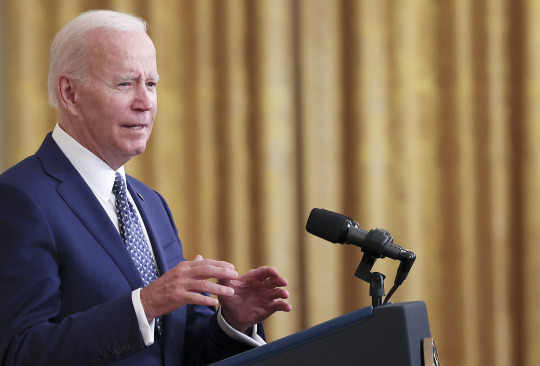
President Joe Biden delivers remarks in the East Room of the White House, June 13, 2022, in Washington, DC.
Win Mcnamee/Getty Images
Former White House press secretary Jen Psaki reiterated in 2021 that President Biden supported the study of reparations. However, when asked if he would support a bill on reparations Psaki said, "We'll see what happens through the legislative process."
Asked if Biden supports an executive order on the study of reparations, Psaki said at the time, "it would be up to him, he has executive order authority, he would certainly support a study, and we'll see where Congress moves on that issue."
A White House official told ABC News on Thursday, President Biden still "supports a study of reparations and the continued impacts of slavery but he is very clear that we don't need a study to advance racial equity."

Nkechi Taifa, center, speaks at Vote For Justice: An Evening of Empowerment with activists and artists at the Newseum, May 9, 2018, in Washington.
Paul Morigi/AP, FILE
Nkechi Taifa is director of the Reparation Education Project, and has been calling for reparations for moire than 50 years. In 1987, she was one of the founders of the National Coalition of Blacks for Reparations in America (N'COBRA), an organization that worked closely with Democratic Rep. John Conyers to draft the introduction of H.R. 40 in 1989. She says now is the time for Biden to sign an executive order so the commission can be up and running before the end of Biden's presidency.
Taifa says she hopes the display at the ellipse sends a message that reparations advocates need to be paid attention to, and Black people should not be taken for granted.
She told ABC News, "If they think they're gonna rest on Juneteenth because it's a holiday and a watered down policing reform bill -- that's not enough. Black people have been run roughshod over, you know, for centuries, and it just, it just cannot continue."
Joan Neal, deputy executive director and chief equity officer at NETWORK, a social justice advocacy group founded by U.S. religious sisters tells ABC News, that "Slavery was a sin, that was the original sin of this country, and we believe that unless you acknowledge your sin and you make a firm determination to never do it again, and then make restitution for what was lost. You still have not been forgiven."
She added, "All parties have to be willing to stand up and face the sin in order for the sin to be forgiven and in order for things to be whole again."
4 notes
·
View notes
Text
Kelly Gallagher is a filmmaker, animator, and Associate Professor of Film at Syracuse University. She is the recipient of a 2024 Creative Capital award. Her handcrafted films and commissioned animations have screened at venues including: the Museum of Modern Art, the National Gallery of Art, Sundance Film Festival, Tribeca Film Festival, and the Smithsonian Institution. Recent commissioned animations have screened on Netflix and PBS. She’s presented solo programs of her work at institutions including: SFMOMA, Close-Up Cinema London, SF Cinematheque, and Wexner Center for the Arts. Kelly enthusiastically organizes and facilitates fun and inclusive film workshops and camps for communities of all ages, from Kentucky to California, from New York to Iowa and beyond.
0 notes
Text
Unleashing Film Festival Success: Strategies for Maximum Impact
Maximizing the impact at film festivals can greatly boost your movie's exposure, acclaim, and potential for future ventures. Crafting an effective strategy begins with thorough planning and investigation. Initially, selecting the appropriate film festival is essential. Look into those that match your film's genre and intended audience, taking into consideration the festival’s legacy, the films it has showcased, and previous winners to discern what resonates at each event. This research will guide you in devising a strategy that improves the chances of your film being well-received.
Strategic Planning
A crucial step to achieving success is establishing clear goals before you submit your film. Whether your aim is to attract new fans, connect with industry experts, or secure future projects, having defined targets will maintain your efforts focused and organized. Furthermore, think about engaging with festival organizers early on; this helps build relationships that might provide advantages like better screening schedules or promotional assistance. Submitting your film early can also enhance your selection chances. Many festivals offer early bird discounts and exhibit more flexibility in their selection criteria during this period. A compelling press kit further aids in making a positive impression; ensure it includes high-quality images, a synopsis, and relevant details that allow your audience to understand and appreciate your work.
Marketing and Promotion
Leveraging social media is a powerful tool for establishing a robust promotional campaign. Start generating buzz before the festival with teasers and behind-the-scenes content that can captivate your audience. During the festival, keep your audience engaged with real-time updates and continue to utilize social media platforms post-event to sustain interest and momentum. Building an online presence is vital for increasing your film's visibility. By engaging with fans and showcasing your performances, you ensure a continuous connection with your audience and industry professionals. Creating buzz around your film can be effectively achieved through social media posts, email marketing, and personal invitations, which are particularly impactful, even with limited resources.
Networking Opportunities
Film festivals also offer excellent networking opportunities. Participating in panels, workshops, and meet-and-greets are great ways to connect with fellow artists and potential partners. Build meaningful connections by approaching conversations with authenticity and showing genuine interest in others' work. These interactions can lead to collaborations and new opportunities.
Managing Burnout
Navigating the festival circuit can be overwhelming, so it's crucial to balance seizing opportunities with maintaining well-being. Create a schedule that incorporates both your professional duties and personal downtime to recharge. Staying organized will help you remain focused and productive amid the whirlwind of festival activities.
Additional Considerations
For filmmakers from specific regions, such as New Jersey and New York, there are extra strategies to consider. Connect with local institutions that align with your film’s themes, which might offer exclusive screening opportunities or additional support. Moreover, participating in local festivals can help you build a following and gain recognition within your community, with events like the Garden State Film Festival and Tribeca Film Festival serving as excellent platforms for exposure. In conclusion, maximizing your film's impact at festivals necessitates strategic planning, diligent research, and effective marketing. Engaging with festival representatives, leveraging social media, and managing personal well-being are crucial components of a successful festival strategy. Through these efforts, filmmakers can not only boost their film's visibility but also open doors to future career opportunities.
#FilmFestival #Filmmaking #Networking #Marketing #FilmIndustry
Maximize your film's impact with expert tips from https://www.kvibe.com
0 notes
Text

Edinburgh Short Film Festival 2024 Fri Oct 25 - Sun Nov 10 2024 Summerhall/French Institute
ESFF 2024 Programme Announced!
From Venice and South by South West Jury winners, alongside winners and nominees from a host of international film festivals, including Cannes, Tribeca, Locarno and Sundance as well as the best Scottish and UK short films of 2024. We’re also hosting guest programmes from our international partner festivals,and on top of all that, we’re hosting networking sessions with special guests, panel discussions and our opening night launch party is hosted by Edinburgh’s own Cinetopia! World standard short films and you’ve fleeting chance to see them so don’t miss out! Tickets & programme now online: https://www.edinburghshortfilmfestival.com/esff-2024-events-programme/
0 notes
Text
Empire City Podcast Premieres: Eight-Part Series on The History Of The NYPD

The New York City Police Department (NYPD) is the largest and one of the oldest municipal police departments in the United States, with approximately 36,000 officers and 19,000 civilian employees. The NYPD was established in 1845, and today, is responsible for policing an 8.5-million-person city, by performing a wide variety of public safety, law enforcement, traffic management, counterterror, and emergency response roles.
The NYPD has also been the source material for thousands of books, TV shows (NYPD Blue, Law And Order, Elsbeth, Brooklyn Nine-Nine. Car 54, Kojak, and many more), and movies such as Serpico. It's logical that Wondery and Crooked Media have announced the premiere of Empire City, an eight-part narrative series investigating the fascinating and largely invisible history of the New York Police Department (NYPD). Created and hosted by Peabody Award-winning journalist Chenjerai Kumanyika (Uncivil),Empire City provides a window into New York City’s past and insights into the foundations of law enforcement in America. Empire City debuts ad-free on Wondery+ and all other podcast streaming platforms on September 9th. Listen to the trailer HERE
With the future of policing front and center in American politics, Empire City reveals the often-hidden and suppressed history of where and when it all began. An official selection of the 2024 Tribeca Film Festival, Empire City begins by painting a vivid portrait of New York City in the mid-1800s: A town overrun with labor protests and deadly riots, vice, racial conflict, police constables kidnapping freed Black people and sending them into slavery, a burgeoning abolitionist movement and the first true-crime stories - peddled by newspapers. In each episode, Kumanyika walks listeners through pivotal moments that challenge misconceptions about present day policing and politics. Among topics covered are how the fight over by-mail abortion pills today can be traced back to an evangelical vice fighter who was determined to shut down New York brothels; and how riots on the streets of New York led to officers being armed for the first time. Empire City features voices of historians, grassroots tour guides, and organizers like Mariame Kaba, Leslie Alexander, Asad Dandia, Khalil Gibran Muhammad, Kamau Ware, and Jonathan Wells, as well as descendants of early police officers and resistance fighters, and former police officers who provide unparalleled insights into the history of policing in New York. Kumanyika is a scholar, journalist and assistant professor at NYU’s Arthur L. Carter Institute of Journalism who specializes in using narrative non-fiction audio journalism to critique American ideological myths about topics such as race, the Civil War, and policing. Kumanyika’s ties to the topics at hand in Empire City are deeply personal as the son of Makaza Kumanyika, a prominent civil rights organizer who was wrongly arrested and surveilled by the NYPD for leading peaceful protests against police brutality. Kumanyika was the co-executive producer, co-host, and co-creator of Uncivil, a Peabody-awarded podcast on the Civil War produced with Gimlet Media. He was a co-host and collaborator on Scene on Radio’s Peabody-nominated series Seeing White and its fourth season on the history of American Democracy. Kumanyika has also been published by NPR, The Intercept, VICE, and Transom, and he has appeared on NPR Code Switch, All Things Considered, Invisibilia, and numerous other scholarly platforms and publications. Empire City is a Wondery and Crooked Media production. The show is executive produced by Wondery, Crooked Media and PushBlack.
Wondery, an Amazon company, is a podcast studio known for Dr. Death, British Scandal, Even the Rich, and Business Wars, and distribution of hit partner shows Morbid and How I Built This. In 2017, former Obama staffers Jon Favreau, Jon Lovett, and Tommy Vietor started Crooked Media with Pod Save America—a well-received politics podcast. Since then, they’ve continued to add new shows, voices, and opportunities for activism through their Vote Save America platform. PushBlack is the nation’s largest nonprofit media organization for Black Americans, reaching nine million people across multiple platforms. They tell empowering stories of Black life and history that inspire people to take liberating actions in the best interest of Black communities.
Check out Empire City. You deserve the truth, if you can handle it.
0 notes
Text

Thelma Schoonmaker
Legendary Film Editor Celebrates Late Husband Michael Powell by Debuting The Doc "Made in England: The Films of Powell and Pressburger" at Tribeca Fest and More
By Brad Balfour
Maybe I should have attended the opening night screening of Black Narcissus when Oscar-winning director Martin Scorsese introduced the Museum of Modern Art's [MoMA] retrospective of Michael Powell and Emeric Pressberger films, but I didn't. Instead, I made it the next night to see legendary film editor, Thelma Schoonmaker, share her thoughts about Powell – her late husband – when the institution screened Made in England: The Films of Powell and Pressburger.
But hell, Marty was the sole narrator of this definitive documentary, so we hear him speak throughout a whole film celebrating the late Michael Powell and his partner, Emeric Pressburger, directed by David Hinton. In fact, Schoonmaker was introduced to Powell by Scorsese and his London-based film producer, Frixos Constantine. The couple were married from May 19, 1984, until his death in 1990. Since they had no children, Schoonmaker has been devoting herself to honoring and preserving the legacy of the many classic films that Powell directed.
Born in January 1940, this American film editor is best known for her five decades-long collaboration with Scorsese. Schoonmaker started working with Scorsese on his 1967 debut feature film, Who's That Knocking at My Door, and has edited all of his films since 1980's Raging Bull. Awarded many accolades, she has won three Academy Awards, two BAFTA Awards, and four ACE Eddie Awards. The 84-year-old has been honored with a British Film Institute Fellowship in 1997, the Golden Lion for Lifetime Achievement in 2014, and the BAFTA Fellowship in 2019.
In close collaboration with the British Film Institute (BFI), MoMA has been screening a comprehensive retrospective honoring this legendary filmmaking duo, creators of such classic films as The Red Shoes, A Matter of Life and Death and Black Narcissus.
Powell's controversial 1960 film Peeping Tom was so vilified on first release that it seriously damaged his career, but it's now considered a classic and a contender for the first "slasher movie." Besides Scorsese, many renowned filmmakers such as Francis Ford Coppola and George A. Romero have cited Powell as an influence.
In 1981, he received the BAFTA Fellowship along with partner Pressburger – the highest honor the British Academy of Film and Television Arts can bestow upon filmmakers. This series – the largest and most wide-ranging exploration of their work ever undertaken – celebrates the duo's cultural legacy and enduring influence. It features several 35mm prints, as well as new digital restorations of such Powell and Pressburger classics as The Small Back Room, The Life and Death of Colonel Blimp and The Tales of Hoffmann. Rarely screened films from Powell's late period will include Oh... Rosalinda!!, The Battle of the River Plate, Peeping Tom, and his long-unavailable 1963 adaptation of Bela Bartok's opera, Bluebeard's Castle. The latter two are newly restored by the BFI National Archive and the Film Foundation.
These true cinematic visionaries and innovators worked together on 24 films between 1939 and 1972, with Powell directing and Pressburger responsible for the scripts – though their duties blended often enough. For the films they produced together as The Archers, their credit reads "Directed and written by Michael Powell and Emeric Pressburger." The Archers worked with an exceptionally talented group of longtime collaborators who helped to craft and deliver their narrative worlds.
When Schoonmaker introduced the doc at MoMA, she offered these comments:
"I'm very glad that you are going to have a chance to see what it's like when I work with Marty. From the time I met him, he talked about the films of Powell and Pressburger. And when videos finally came around, he would send me home with one from the editing room so I could actually see why he was so excited. Of course, when I saw the films, I became as excited as he was. When he introduced me to Michael Powell at a dinner, while we were editing Raging Bull, I was stunned by him. "Much to the amazement of everyone, including Michael and myself, we began a relationship and eventually married. Michael was with us in New York from The King of Comedy until the film Goodfellas. He loved being back in the film world, and his presence meant so much to Marty as you will see in the documentary. So here's just a few notes, [then] we can get into the documentary about Michael's time with us in New York.
"We have all these great masterpieces to try and get down to a length that's reasonable. Michael would stop me on the street in New York sometimes and demand indignantly, "Why isn't Mean Streets being run every day somewhere in New York City?" He thought it was a masterpiece. He's right.
"Michael gave us the ending for After Hours. We didn't have a strong ending, and some people were giving us ideas like Cheech and Chong should fly away in a balloon. But Michael said no. Richard Dunn has to go back to the hell where we first saw him, teaching someone how to use a computer when what he really wants to do is write a great American novel. That's what Marty shot.
"When The Last Temptation of Christ was under such severe attack even before it was released, we had to have bodyguards for Marty. Marty finally let Michael see an almost finished edit of the film. He was always so worried about showing Michael any edits of our films because he said if he doesn't like it, I'm going to jump out the window. At the end, Michael stood up and there were tears streaming down his face. And I thought, what an incredible gift that was for Marty to be given at that terrible time.
"Most importantly, when Marty couldn't sell Goodfellas to the studios, if you can believe that, because they said he had to take the drugs out. He said, 'I can't.' That's the story. So I think that's in the editing room when I told Michael about it. He got very upset. He said he was ferociously protective of Marty's artistic rights because of what he, himself, had suffered. "And he told me to read him the script. When I finished, he said, get Marty on the phone. When I did, he said to Marty, "This is the best script I've read in 20 years. You have to make it." Marty went in one last time and got it made. Can you imagine if Goodfellas had never been made? But Michael did not live to see it.
"In return, what Marty has done for Michael and Emeric, is so enormous. Nobody's done as much as him to bring the films of Powell and Pressburger back from oblivion, in which they lingered for more than 20 years. He brought Michael Powell to the US, took him to film festivals where he got awards, entered Peeping Tom into the New York Film Festival in 1980, arranged for its re-release in America. And through his film foundation, he has raised the funds to restore eight of the Powell-Pressburger films. That is only a small list of what he has done through the years.

"So when Nick Varley, one of the producers of Made in England: the Films of Powell and Pressburger, suggested making a documentary about them, Marty and I were thrilled. We knew that it should be directed by David Hinton, who had already made a lovely film for the South Bank show on British TV about Michael Powell, when he was still alive and when his autobiography was published. Hinton took everything Marty had ever said or written about Powell and Pressburger and in conjunction with Marty, skillfully created the beautiful script you are about to see.
"David also insisted that Marty should be the only host in the documentary. No talking heads. How right he was. When Marty and I finished working on that little film, Killers of the Flower Moon, We joined into a wonderful collaboration with David and his editor Margarida Cartaxo. Edits flew back and forth across the Atlantic. It was a great joy for me to be living with the great films that I loved so much. You'll see a long list of organizations that funded the documentary, for which we are very grateful. With special thanks to George Harrison's widow, Olivia, who came in at the end to give us a much-needed boost.
"Just in time, for there is an explosion of interest in the films of Powell and Pressburger around the world. The British Film Institute, at the end of last year, put on a major retrospective of their films. Large numbers of young people attended the packed screenings and events. Now, MoMA, collaborating with the BFI, has put on an equally major retrospective for you all to see.
“We are so grateful to Dave Kehr, Olivia Priedite, and Sean Egan for the huge job of getting 50 films here for us all. And because of the amazing interest in the documentary, it is being distributed around the world, even in Beijing, where they screened it three times. We are so grateful to Altitude Movie and Cohen Media for making this possible.
"To end, I want to give my undying thanks to Marty, for letting me help him edit 22 of his movies, for initiating me into the Powell-Pressburger cult and for giving me the most wonderful husband in the world."
In addition, after Tribeca Festival debuted Made in England/The Films of Powell & Pressburger, MoMA's retrospective began. In presenting the doc there, Schoonmaker answered a few questions from a moderator about the film:
What is it like watching this?
Oh, it's so emotional. This film was made with quite a few people who really love Powell. It came out of years of Marty sending me home with videos of their movies and educating me about them and talking about them all the time. The producer of this film, Nick Varley, suggested to me that we make a documentary about it because of the wonderful celebration of Powell and Pressburger last year in England, in which I participated a lot.
Now MoMA is doing exactly the same celebration. They're going to run 50 films of these men. I never get tired of these movies and was so thrilled to be part of it. Marty's deep emotion about this movie is just what makes it so strong. Nobody ever did more to bring Powell and Pressburger back to the world than Marty. Many other people – Ian Christie, Kevin Goff Yates, Bertrand Tavernier – did great work to bring it back. But it was Marty who really, because of his ability to create publicity for them, made sure that the Museum of Modern Art ran a retrospective many years ago. Getting Peeping Tom reissued, all these things Marty did. Then he introduced my husband to me. It's an amazing thing to share with you all. And I do hope you'll go and see things at the Museum of Modern Art. Yes, definitely.

This is such a fascinating documentary, and it's very much a love story from Scorsese to them.
When I went to the celebration in England, there were so many young people there. I would look out at the audience, and half of them would be young people. They are coming in droves to these meetings. They're rediscovering them. I went up to Toronto to show this documentary, and after that they ran 10 films of Powell and Pressburger. They said it was packed with young people. Michael and Emmerich would be so thrilled to know that. Any time would have been the right time, but we seem to have accidentally hit a particular moment. That is wonderful.
Talk a little bit about the decision to tell the story of Powell and Pressberger's career through the lens of another filmmaker?
I think David – this movie's wonderful director – said that he wanted Marty to be the host. He didn't want a lot of talking heads. But he said, "No, I just want one person. I want Marty to do it." Of course, we agreed. I think he was absolutely right.
He's been a champion for their films for such a long time. you can really feel the love and connection to their films through his films.
Yes, I think he's probably one of the best working filmmakers who can talk about film.
You made an interesting choice with the film to highlight just a few of the films. Do you think that there is one film that you could pick that is the most meaningful or most special to you from Powell and Pressburger?
I hate that question because that's like saying, which of your children do you like best? I love them all. But my personal favorite is The Life and Death of Colonel Blimp, which I accidentally saw when I was 15. We weren't allowed to watch TV except when our mother chose what we should watch at night. But my mother worked as a nursery schoolteacher, and I got home before her from high school, and I turned on this wonderful million-dollar movie that Marty talks about in the documentary where they ran the same film nine times in one week. Marty would try and watch them nine times unless his mother got fed up and stopped him. I just happened to turn on the TV and there was this amazing film. I will never forget it. It just marked me so deeply. Little did I know that I would, many years later, meet the director and marry him.
Michael's personal favorite was A Matter of Life and Death. He loved being a magician and he could do anything he wanted in that movie. Create heaven and earth, forget all about continuity and the things we're supposed to do when we make films. Just do what was right. Of course, Rex Ingram – the director that he worked with at the Victorine Studios when he was young – had inspired him with this love of magic. So that was his favorite.
Made in England: The Films of Powell & Pressburger Opens Friday, July 12th Q&As with Thelma Schoonmaker, 7/12 & 7/13 The Quad 34 W 13th St. New York, NY 10011 Contact: [email protected]
Copyright ©2024 PopEntertainment.com. All rights reserved. Posted: July 12, 2024.
Photo #1 by Dan Diaz © 2024. All rights reserved.
Photos #2 & 3 © 2024. Courtesy of Cohen Media Group. All rights reserved.
youtube
0 notes
Text

The Screen is a Mirror
Short Films + Artist Panel
Co-presented with Trinity Square Video, and BUMP TV
when:
SATURDAY, 30 MAY 2020, 5-6PM
& again on WEDNESDAY, 3 JUNE 2020, 7-8PM
where:
https://www.bumptelevision.com
Zoom opening reception for VIDEO FEVER and THE SCREEN IS A MIRROR held on Saturday, 30 MAY 2020, 6:30PM. For details, email [email protected]
Online Exhibition 4-30 JUNE 2020, www.gloryhole-gallery.com
ARTISTS:
Thirza Cuthand, Jeremy Saya, Umber Majeed, Kim Ninkuru
Curated/Moderated by Karina Iskandarsjah & Emily Peltier
The Screen is a Mirror is a screening event and artist panel about intentional space-making and radical self-love; showcasing works that imagine methods in which queer and racialized identities can be fostered for survival, belonging and flourishing. Artists Thirza Cuthand, Jeremy Saya, Umber Majeed and Kim Ninkuru experiment with self-portraiture, performance, narrative formats, collage and pastiche to express playfully nuanced experiences and desires of love, acceptance, assimilation, freedom, and being unapologetically joyful.
–
Artist bios:
Thirza Cuthand grew up in Saskatoon. Since 1995 she has been making short experimental narrative videos and films about sexuality, madness, Queer identity and love, and Indigeneity, which have screened in festivals internationally, including the Tribeca Film Festival in New York City, Mix Brasil Festival of Sexual Diversity in Sao Paolo, ImagineNATIVE in Toronto, Frameline in San Francisco, Outfest in Los Angeles, and Oberhausen International Short Film Festival. Her work “2 Spirit Dream Catcher Dot Com” uses a Butch NDN “lavalife” lady (performed by director Thirza Cuthand) to promote a website that seduces the viewer into 2 Spirit “snagging and shacking up” with suggestions of nearby pipeline protests to take your date to, and helpful elders who will matchmake you and tell off disrespectful suitors. It’s the culturally appropriate website all single 2 Spirit people wish existed.
Jeremy Saya is a queer interdisciplinary artist based in Toronto whose practice integrates elements of performance, installation, sound, video and electronics. His academic background in philosophy and social science often informs his work which deals with queerness, the body, identity, vulnerability, ephemerality and interactionism. Jeremy has performed at Ignite Gallery and at Cold Waters Media Arts Symposium & Festival in North Bay, Ontario. He has exhibited at Defibrillator Performance Art Gallery, White Water Gallery, Beaver Hall Gallery, VSVSVS, and has curated film programs for both the Toronto Queer Film Festival and Images Festival. Jeremy has worked at Vtape, Feminist Art Gallery, Trinity Square Video and currently holds the positions of Programmer and Box Office Manager at Images Festival. In the work “Perfect”, Saya uses video as a tool to process feelings of shame and perfectionism. By using humour, self-reflection and editing, Saya explores the irony of wanting to be the best at embracing imperfection.
Umber Majeed (b. New York) is a multidisciplinary visual artist. She received her MFA from Parsons the New School for Design in 2016 and graduated from Beaconhouse National University in Lahore, Pakistan in 2013. Her writing, performance, and animation work engage with familial archives to explore Pakistani state, urban, and digital infrastructure through a feminist lens. In “Still Life” and “Two Fridas”, Majeed speaks to the disconnect she encounters in Western art institutions. As a Muslim woman living in the United States, she takes up the role of the “outsider from the inside”, exploring concepts of existentialism, identity, and self-representation.
Kim Ninkuru is a multimedia artist from Bujumbura, in Burundi, currently residing in Toronto. She uses performance art, installation, video, spoken word and movement to create pieces that give her the chance to explore and express rage, love, desire, beauty, or pain in relation to her own body and mind. Her work heavily questions our preconceived notions of gender, race, sexuality and class. It is grounded in the firm belief that blackness is past, present and future at any given moment. The video work “Dodo NightClub” comes from a need to imagine safer spaces for black femmes to dance and experience joy late at night. The word “dodo” comes from the french expression “faire dodo” meaning “going to sleep”. In this context, “dodo nightclub” is the safe place you go to party: your room.
0 notes
Text
Exploring the Intersection of Art, Fashion, and Culture in NYC

New York City stands as a vibrant hub where art, fashion, and culture seamlessly intertwine, creating a dynamic landscape that continually inspires and evolves. The city's rich tapestry of cultural events and artifacts provides a unique backdrop for exploring these intersecting realms, especially during high-profile occasions like New York Fashion Week.
Art and Fashion Magazines
Art and fashion magazines play a pivotal role in documenting and shaping the cultural zeitgeist of NYC. Publications such as *Vogue*, *Harper's Bazaar*, and *Artforum* not only highlight the latest trends and artistic innovations but also provide in-depth analyses of the cultural significance behind them. These magazines serve as vital platforms for both established and emerging artists and designers, offering readers a curated glimpse into the creative processes that drive the city's vibrant scenes.
NYC Culture Events
New York City's cultural calendar is brimming with events that celebrate its diverse heritage. From the annual Tribeca Film Festival to the Armory Show, these events draw artists, critics, and enthusiasts from around the world. They offer an unparalleled opportunity to engage with contemporary art and fashion while also honoring the historical and cultural contexts that shape them. Street fairs, gallery openings, and theatrical performances further enrich the city's cultural landscape, ensuring there's always something new and exciting to explore.
Cultural Artifacts
The city's numerous museums and galleries house a wealth of cultural artifacts that reflect both its history and its ongoing evolution. Institutions like the Metropolitan Museum of Art and the Museum of Modern Art showcase works ranging from ancient relics to cutting-edge contemporary pieces. These artifacts not only preserve the city's rich artistic heritage but also inspire new generations of artists and designers. The fusion of historical and modern influences is a hallmark of NYC's artistic community, fostering a creative dialogue that transcends time and geography.
New York Fashion Week
New York Fashion Week (NYFW) is undoubtedly one of the most anticipated events in the fashion world. It serves as a global stage where designers unveil their latest collections, setting trends that resonate far beyond the city's borders. NYFW is not just about the runway shows; it's a cultural phenomenon that brings together industry insiders, celebrities, and fashion enthusiasts. The week is filled with glamorous parties, exclusive previews, and networking opportunities that highlight the city's role as a fashion capital.
In conclusion, New York City's art and fashion scenes are deeply intertwined with its cultural events and historical artifacts. Together, they create a vibrant, ever-evolving landscape that continually inspires and captivates. Whether through the pages of a magazine, the halls of a museum, or the runways of NYFW, the city's unique blend of creativity and culture is always on full display.
0 notes
Text
Hermann Lederle
Critically admired german artist Hermann Lederle is most prominent for his PIXEL and BLOTS painting and more recent ADAPTATION series. His works have shown in numerous exhibitions around the world, and his artistic production is particularly unique and recognizable. Although initially the impression is abstract, Lederle's works feature geometric elements that compose, as a whole, figurative elements, bringing to mind that of the abstract expressionists.
Los Angeles artist Hermann Lederle is known for his innovative BEAUTIFUL CHAOS abstract canvas scapes and unique BREAKAWAY layered PIXEL painting. Blurring the boundaries between paint-scape and landscape reality, and between the paint and its intended object, the work combines geometric abstraction and pure color concept to explore a new ethereal thematic. Through a PILLING of dotted lines and multitude of hyper-glow colors - as if the artist intends to assault the surface with micro-nuclear forces, Lederle constructs a next generation art-scape.
Upon graduating from Karl Friedrich School Mannheim for humanist and classic studies in Germany, Lederle re-directed his career path. His early apprenticeship training in photography inspired him to seek a formal continued education in the Fine Arts, namely filmmaking and painting at the San Francisco Art Institute. San Francisco became his new residency for the next years until graduating with a BFA, followed by five years establishing himself as a painter in the thriving arts district of Tribeca in downtown New York City. It was there, Lederle began to formulate his own visual language to express his concepts and ideas through the lens, on canvas and on the film screen. Exemplifying the artist’s interest in the interaction between art and film and creating an additional link to 21st century web based digital art, Lederle's painting strives to wipe clean the slate of conventional notions of image construction.
Lederle's PIXEL series, first shown at Media Rare Gallery in Hollywood suggests a kind of Cubism for the digital age. His work as a filmmaker cross-pollinates in subtle, oblique ways. The idea of pixel paintings originated when working with digital images. “It was a discovery. We may have been seeing this way unconsciously since human beings had eyes, but now that we know we can zoom in on something, and then zoom out and see the whole picture, it becomes an awareness we can use to appreciate the pixilated version. Kind of like a primal, pre-conscious experience that relates to the era of technology."
Lederle's FOOTPRINTS ON SNOW series entails a two stage process, where a graduated color is applied with a tractional brush allowing for the distinct qualities of its stroke to emerge. The second stage is executed with a painter's knife often with ostensibly contradictory linear shapes and lines, imbuing it with the properties of rival perceptions, irreversible like footprints, taking place within the canvases.
More recently, in his so-called ADAPTATION series, those vertical bands consist of the vivid and expressionistic decades-old paintings that Lederle has painstakingly hand-cut and then collaged onto the canvas, leaving just enough space for original marks to show through as interstices of the canvas. Punctuated with a stop and go rhythm, the work reigns in the artist’s prior unbidden flourishes and lays bare the source of artistic inspiration, simultaneously suggesting themes of evolution as they relate to Lederle's own practice and reflections on art history.
His latest works in submission on the occasion of IN SPRING Exhibition 2024, recall the BLOTS-pointillism of the neoimpressionists. When purposely set against a SCHIENA SCURA - dark FOAM bubbles, the painting is calling out a messy, un-ordered free floating imagery of some scenery not quite in focus and frozen in a still frame, although its kinetic forces relentlessly pushing up against its limits. The experimental composition of primal shapes and lines striving for a creative expression of artificial, nearly molecular spaces in another dimension and direction. These images take time to absorb, asking you to invest and trust, not speed through in a frenzy. A new-dimensional structure slowly emerges transcending past traditional geometrics.
Hermann Lederle's work has been exhibited in the United States in New York, Los Angeles, San Francisco and Canada, Germany, Italy, France and Hungary. A body of his work is in consignment at galleries, including DSV Kunstkontor Stuttgart, HPH Siebdruck Echterdingen Germany, Media Rare Gallery Los Angeles, Court Gallery New York, Lawson Galleries San Francisco, Friedman Guinness Gallery Heidelberg, and in private collections of Ringo Starr, Eric Stolz, Cal Zecca, Gabor Csupo.
Lederle lives and works in Los Angeles, California. Previous notable exhibitions took place at M.A.D.S. Art Gallery ANDRENOCHROMO FOR DINNER Milan Italy 2022, ART KARLSRUHE HPH Special Serigraph Exhibition Germany 2020, Silverman Studio Hollywood 2017, Vertiva Stuttgart Germany 2015, Arthea Galerie Mannheim Germany 2015, Frank Pictures Gallery Santa Monica 2012, Solaris Gallery Los Angeles 2005, FP Gallery Los Angeles 2005, Media Rare Gallery Hollywood 2001, Lawson Galleries San Francisco 1987 and Court Gallery New York City 1986.
0 notes
Text
Tech and innovation Tuesdays
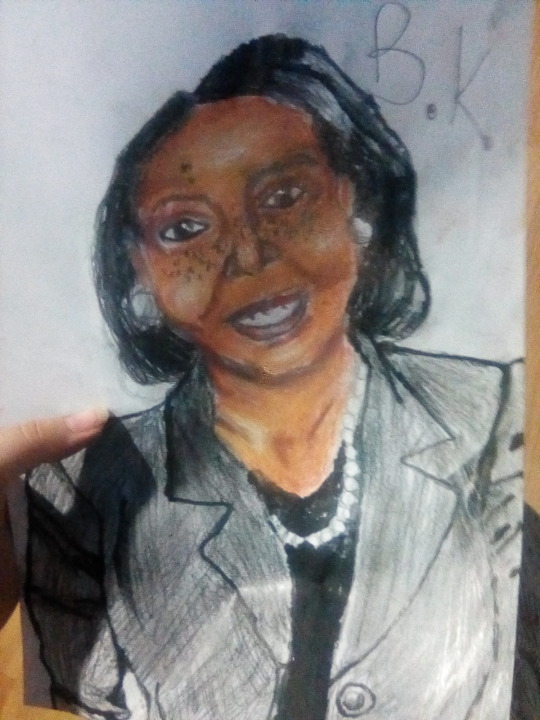
This is the drawing of Patricia Era Bath, an ophthalmologist. She was born on November 4th in 1942. New York. She was actually the first female member of the Jules Stein Eye institute. And she was the one who invented laserphaco which is a surgery for cataract used worldwide, she got awarded from:
NAACP Legal Defense and Educational Fund's Black Woman Achievement Award
Smithsonian Museum's Lemelson Center
American Medical Women's Association
Tubman's Sheila Award
Tribeca Film Festival Disruptive innovation Award
Association of Black Women Physicians Lifetime Achievement Award
Alpha Kappa Alpha presidential Award for health and medical sciences
Howard University Charter day award for Distinguished Achievement in Opthalmology and medicine
Medsape one of 12 'Women Physicians who changed the course of American Medicine'
New York academy of medicine John Stearns Medal for Distinguished Contribution in Clinical practice and for invention of laserphaco cataract surgery
Alliance for aging research Silver innovator award
She died on May 30th in 2019 due to complications from cancer
She will definitely be remembered
Materials used: Ink, Soft pastel crayons and HB-2 pencil
0 notes
Text
90 Movies in 90 Days: Mayor (2020)
Every day until March 31, 2024 I will be watching and reviewing a movie that is 90 minutes or less. Title: Mayor Release Date: March 5, 2020 Director: David Osit Production Company: Rosewater Pictures | Rise Films | Fork Films | Bertha Doc Society | Tribeca Film Institute Summary/Review: Musa Hadid is the mayor of Ramallah, a city in the occupied West Bank of Palestine, just 10 miles away from…

View On WordPress
0 notes
Text
#Attuned (2024) Meet our Director Laramie Dennis. She has previously worked on the hit tv series Project Runway for more than 100 + episodes and HBO's new hit TV series Winning Time: The Rise of the Lakers Dynasty Season 1
Laramie Dennis is a director and writer committed to telling honest, unexpected stories about complex female characters. Her latest is a micro-budget feature entitled WHERE IN THE HELL, an unlikely road movie set in a not-quite-post-pandemic world, that she's developing with Pipeline Media. LIFE ON sMARS, inspired by a real-life NASA experiment, recently earned her a spot at THROUGH HER LENS: The Tribeca Chanel Women’s Filmmaker Program, along with a development grant from The Tribeca Film Institute. Laramie's shorts have screened at Eve, NewFilmmakers (LA + NYC), San Francisco Frozen, the Vancouver International Film Festival, and the Short Film Corner at Cannes. Before moving to Los Angeles, she spent a decade in New York developing and directing plays, most notably at Jim Simpson and Sigourney Weaver's Flea Theater, where she was a resident director, and at "the downtown powerhouse" Soho Rep. She has a BA in English and Theater from Wesleyan University, and an MFA in Film & Television Production from USC.
#90210XX
0 notes
Text
Unleashing Cinematic Delights A companion to Free movies

In a world fueled by constant connectivity and an inextinguishable appetite for entertainment, the appeal of pictures remains unvarying. Whether you are a film buff on a budget or just someone looking for a cinematic escape without breaking the bank, the realm of free pictures offers a plethora of options to be explored. In this blog post, we'll navigate the geography of free pictures, uncovering the retired gems and avenues where you can indulge in the magic of liars without reaching for your portmanteau.
1. Streaming Platforms More Than Subscriptions
While subscription-grounded streaming services like Netflix and Hulu dominate the digital entertainment scene, lower-known platforms have surfaced as titleholders of free pictures. Tubi, Crackle, and Pluto TV are settlers in this space, furnishing observers with an expansive array of flicks supported by periodic announcements. This announcement-supported model enables druggies to enjoy a different selection of pictures without committing to a yearly subscription figure, making cinematic gests accessible to a broader followership.
2. Public Domain Treasures A Journey Through Time
The public sphere serves as a cinematic time capsule, causing an array of classic and historically significant flicks that are free from brand restrictions. Platforms like Internet Library, Public Sphere inundations, and Project Gutenberg offer a treasure trove of pictures gauging different ages and stripes. From silent film classics to early Hollywood masterpieces, these public sphere gems give a unique occasion to explore the elaboration of cinema without spending a song.
3. Educational Platforms Where Entertainment Meets Enlightenment
For those seeking a more intellectually stimulating cinematic experience, educational platforms present an interesting avenue. Kanopy and SnagFilms, for illustration, mate with libraries and educational institutions to offer free access to a curated selection of pictures, independent flicks, and study-provoking features. These platforms not only entertain but also educate, making them an excellent resource for observers fascinated by probing deeper into the art and societal impact of cinema.
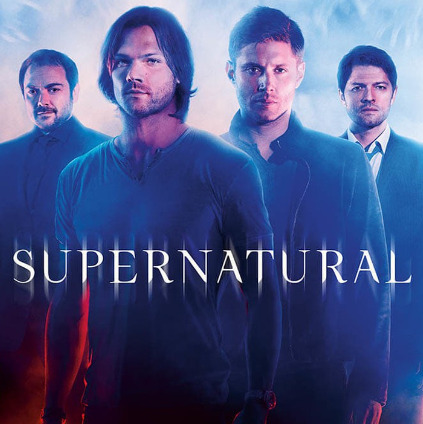
4. YouTube A Global Stage for Creativity
YouTube, frequently synonymous with short vids and vlogs, is also a thriving mecca for independent filmmakers and content generators. innumerous generators Free Movies release their work on YouTube, gauging short flicks to full-length features, covering a different range of stripes. numerous of these generators offer their content for free, using YouTube as a popular platform to reach global followership. This democratization of film distribution on YouTube not only benefits observers but also empowers filmmakers to share their stories without the traditional constraints of assiduity.
5. Film Carnivals Beyond the Red Carpet
Film carnivals aren't solely reserved for the gaudiness and glamour of the red carpet; they also serve as gateways to free cinematic gests. In the digital age, multitudinous film carnivals, including famed bones like Sundance and Tribeca, offer online wireworks of named flicks either for free or at a nominal cost. This democratization of access to jubilee-good flicks allows cults worldwide to partake in the excitement and diversity that these events bring to cinematic geography.
The Democratization of Cinematic Enjoyment
The rise of free pictures Watch Free Movies signifies a vital shift in the democratization of cinematic enjoyment. In a world where the cost of entertainment can be a prohibitive factor for numerous, free pictures break down fiscal walls, icing that the joy of lying through film is a universal experience. This availability is particularly vital for fostering artistic diversity, as free pictures frequently include independent and transnational flicks that might not admit wide theatrical releases.
also, the vacuity of free pictures creates a rich ground for aspiring filmmakers and independent generators to showcase their work to global followership without the traditional constraints of distribution models. This democratization of access empowers filmmakers to tell unique stories, trial with different stripes, and challenge the morals of mainstream cinema.
In conclusion, the world of free pictures is a vast and different geography that extends beyond the boundaries of subscription-grounded streaming services. From announcement-supported platforms and public sphere classics to educational coffers and the global stage of YouTube, the avenues for free cinematic enjoyment are ever-expanding. As we navigate the digital age, let's embrace the openings to explore, discover, and celebrate the magic of pictures without the constraints of a price label. The joy of a good film should be a universal experience, open to all who seek the enchantment of the cinematic escape.
1 note
·
View note